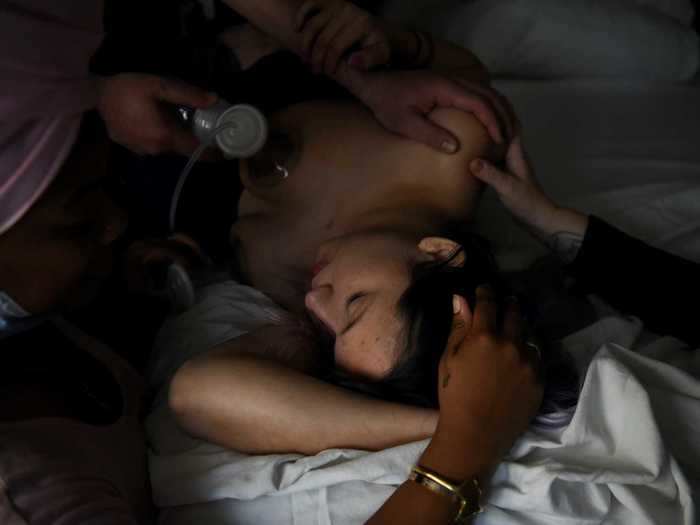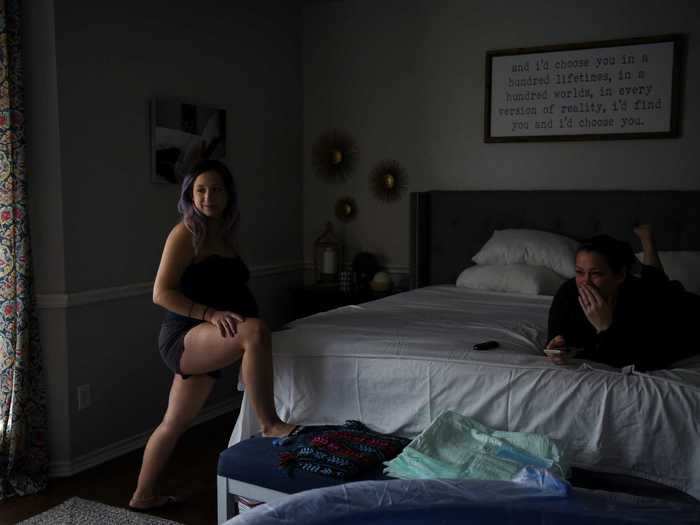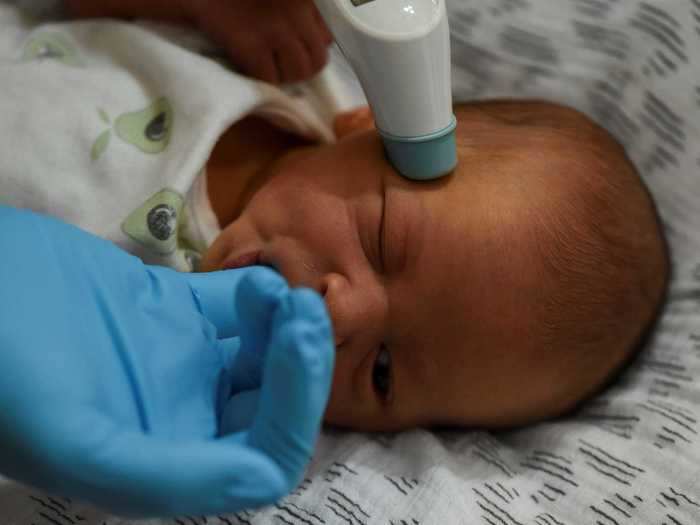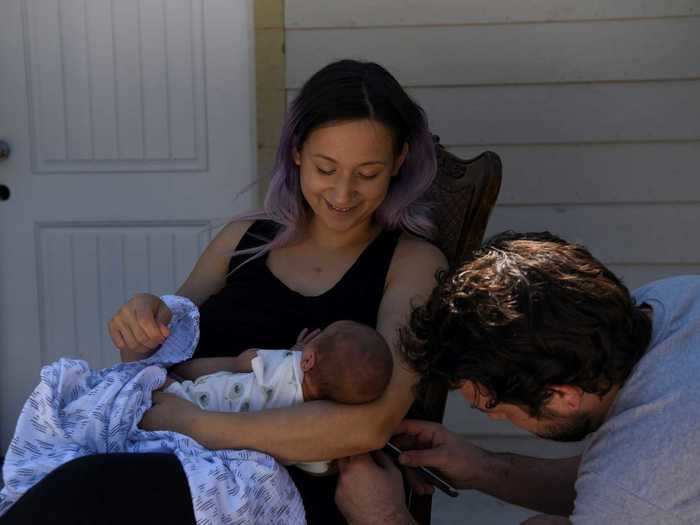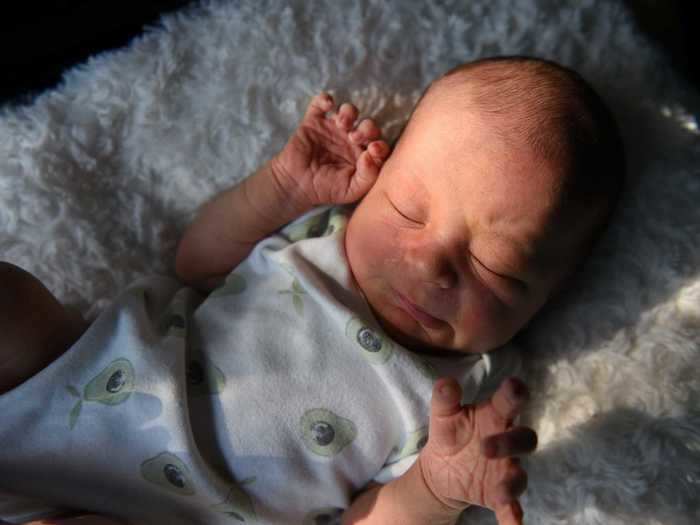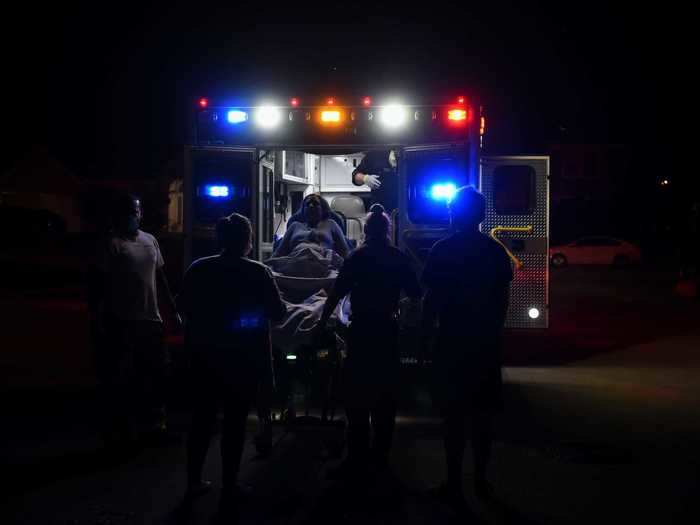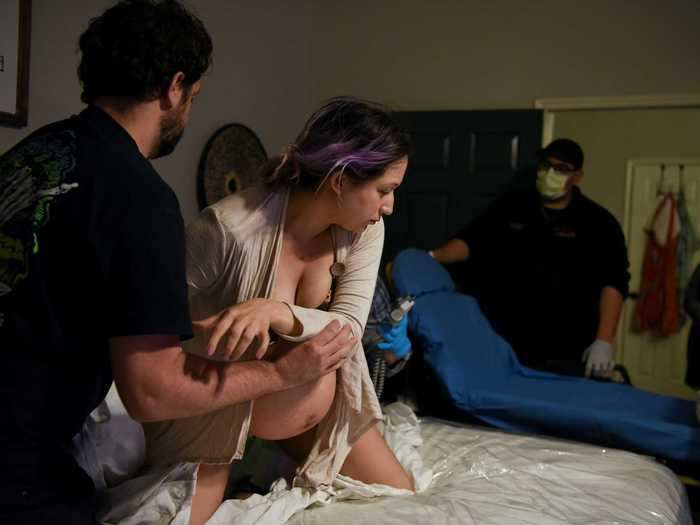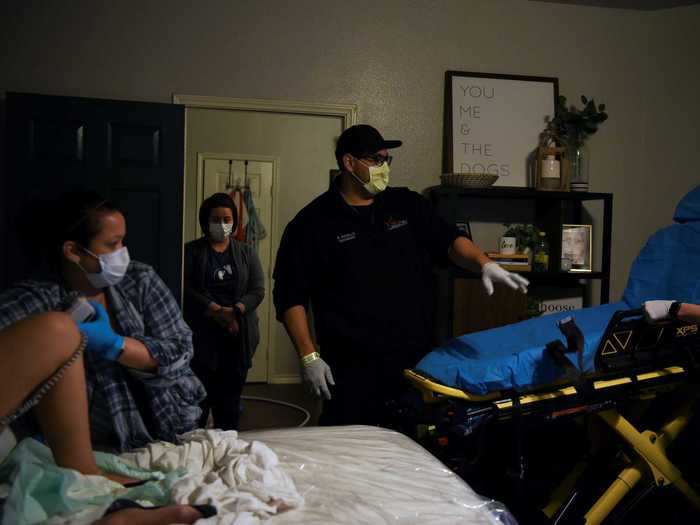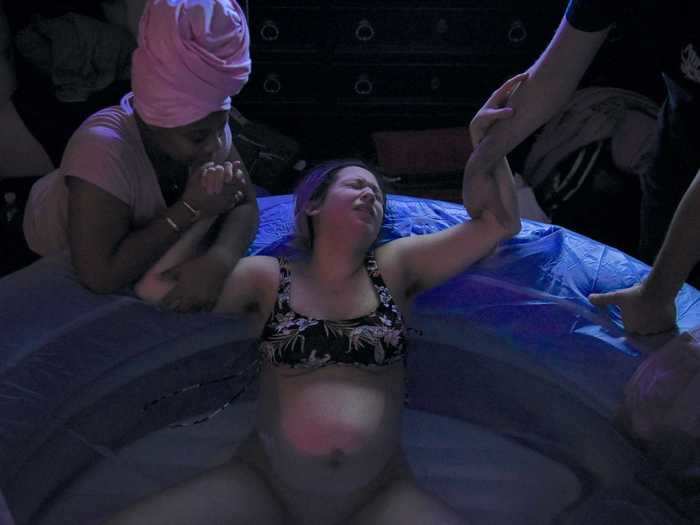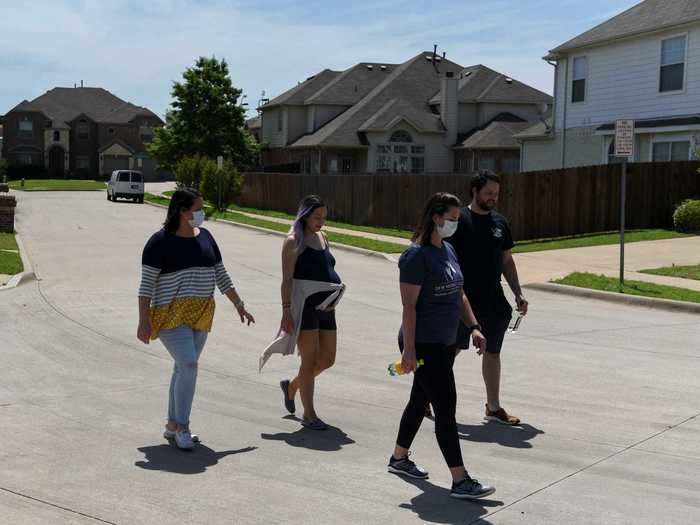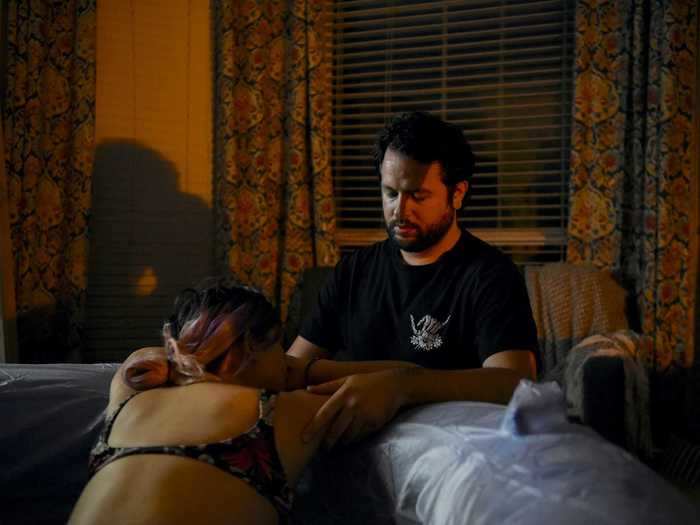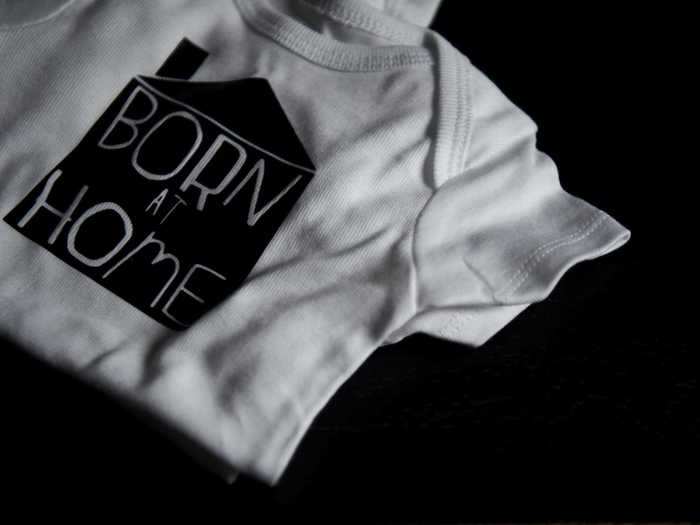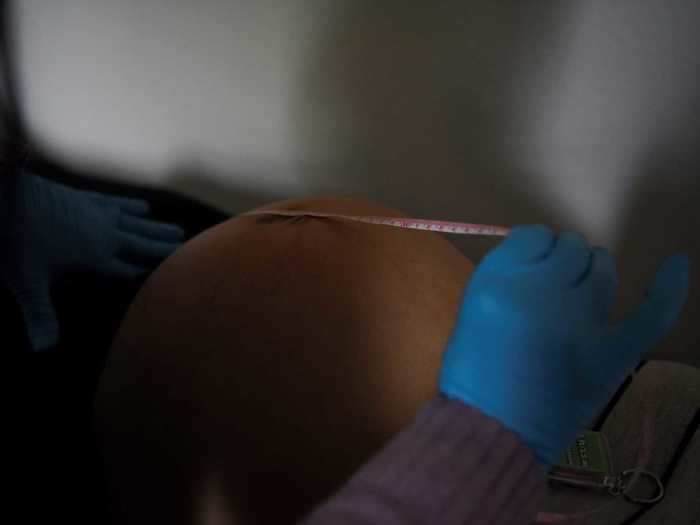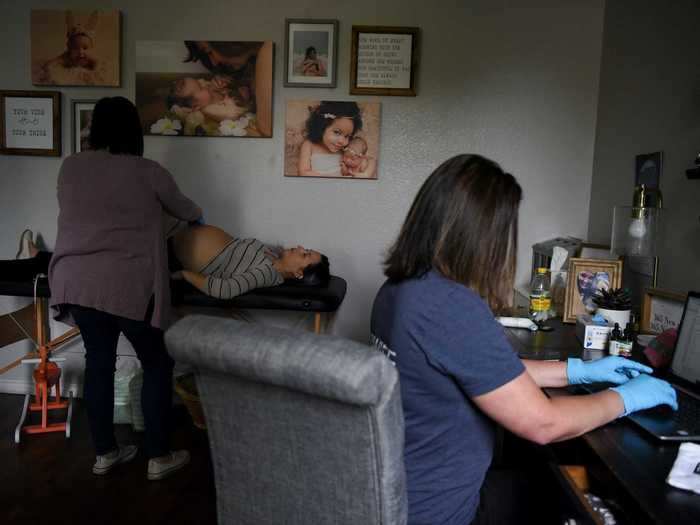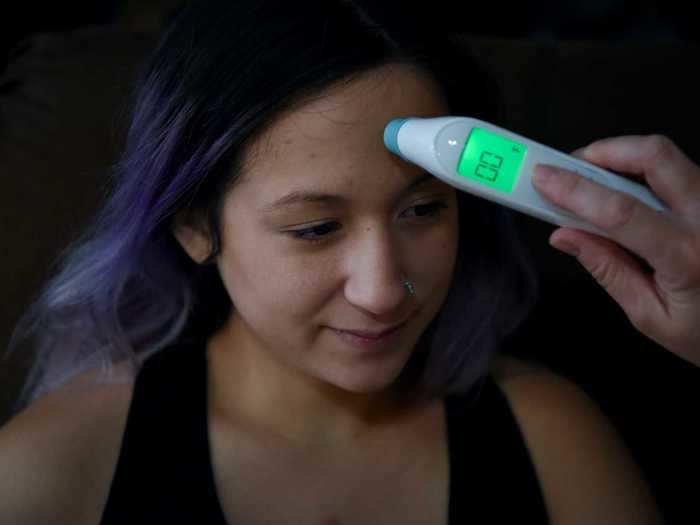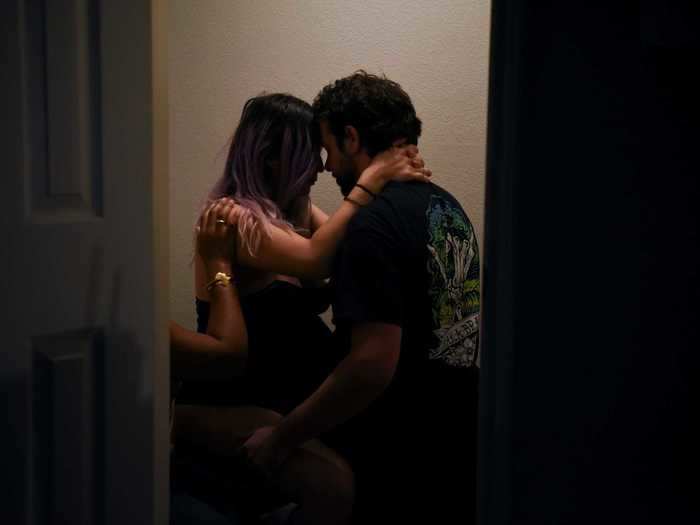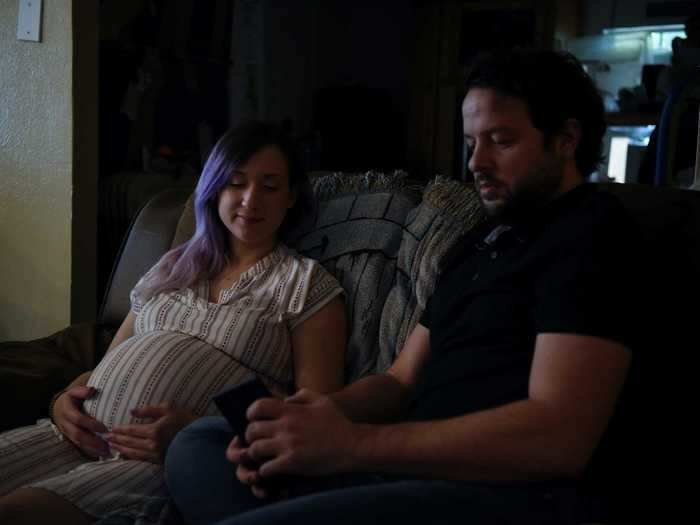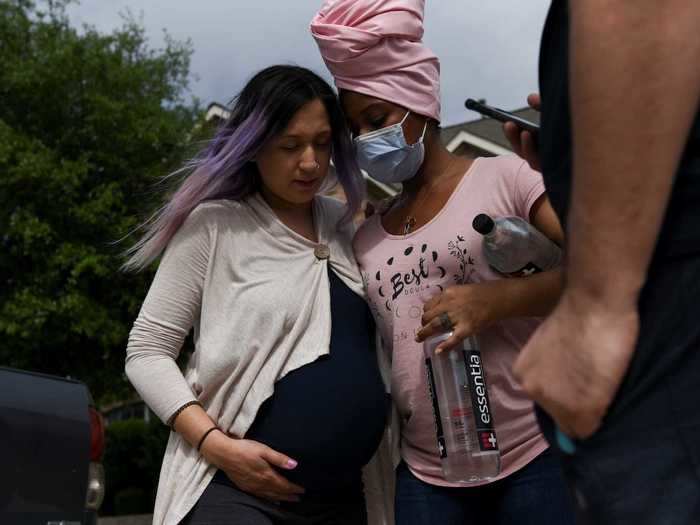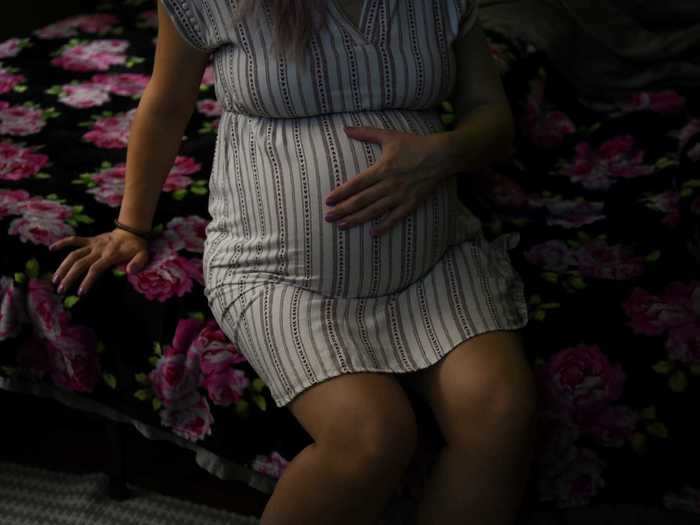Nancy Pedroza, 27, who is pregnant, holds hands with Nichollette Jones, her doula, and Ryan Morgan, 30, her partner and the father to their unborn child, as she experiences contractions in a birthing tub.Callaghan O'Hare/REUTERS
- Nancy Pedroza was 40 weeks pregnant when she decided to give birth at home in order to avoid hospitals overrun with COVID-19 patients.
- Pedroza is among a growing number of women who fear hospital births at a time when states are limiting the amount of people who can be present inside the delivery room, and expecting mothers worry about contracting the coronavirus or exposing it to their babies.
- But after several hours of labor at home, Pedroza began experiencing birthing difficulties. She was rushed to a local Texas hospital and eventually gave birth to a healthy boy on April 8.
- These photos reveal Pedroza's process, and information about birthing safety amid a global pandemic.
- Visit Insider's homepage for more stories.
Nancy Pedroza's worst fear was having to chose who would stand by her side at the hospital when she gave birth: her partner, Ryan Morgan, or her birthing assistant, known as a doula.
The Texas hospital where she had planned her delivery warned Pedroza in late March that only one person would be allowed in the room because of news rules during the coronavirus pandemic. But even that could change, leaving Pedroza to deliver her baby alone.
"Thing were changing so fast," Pedroza, 27, told Reuters' Callaghan O'Hare. She was already going to her obstetrician meetings alone, and the prospect of giving birth in a hospital amid a pandemic frightened her.
So, at 40 weeks pregnant, she turned to a home birth.
Pedroza is not alone — a growing number of pregnant women across the US are turning to non-hospital births in order to avoid exposure and limitations related to the coronavirus. It's a risky option — experts told Insider's Julia Naftulin that suddenly switching your birth plan could be dangerous, and home birth environments are also susceptible to coronavirus spread.
But after hours of labor at home, Pedroza experienced complications and was rushed to a local hospital where she delivered a healthy baby boy.
These photos show her birthing process and offer information about healthy birthing practices amid the pandemic.
Read the original article on
Insider
But doctors warn that expecting mothers should take social distancing efforts seriously, maintain proper hygiene, and avoid contact with sick people, in order to lower their risk of being exposed to the coronavirus. And if you're not sure about how to proceed, contact your doctor.
Prouty and Taylor, both licensed midwifes, conduct a newborn screening for Kai at the house of his maternal grandparent's.
Callaghan O'Hare/REUTERS
Giving birth in a hospital does not necessarily increase the risk of contracting COVID-19. Risa Klein, a well-known New York City-based certified nurse midwife, told Business Insider that hospitals are taking increased precautions in other wards to ensure that patients do not contract the coronavirus. "It's very well-controlled on labor and delivery floors. People are wearing masks, the appropriate PPE," or protective medical gear, she said.
Pedroza experiences contractions as she is carried on an ambulance stretcher to be taken to the hospital by paramedics.
Callaghan O'Hare/REUTERS
Additionally, there is no evidence to suggest that pregnant women are particularly susceptible to the coronavirus. "While I think pregnant women should practice every degree of social distancing that they can because that is just smart, I don't think pregnant women should feel a sense of panic," Dr. and OB-GYN Jane van Dis told Business Insider's Anna Medaris Miller.
Pedroza lies on a bed in front of Jones, her doula, Susan Taylor, her licensed midwife, and Morgan, her partner, as he helps to pump her breastmilk.
Callaghan O'Hare/REUTERS
Midwives have warned that switching from a hospital birth to a home birth at the last minute could lead to complications. Additionally, a shortage of midwives across the country has made switching to home birth more difficult.
Pedroza holds her one-day old newborn son, Kai Rohan Morgan, as she waits for her partner.
Callaghan O'Hare/REUTERS
"Every woman has the right to choose where she will give birth. But it is important to not take any risks that might put you or your newborn's health in danger, especially as there is a high risk for getting COVID-19. Talk with your OB-GYN or other health care professional about your birth plan and any concerns," ACOG's statement says.
Pedroza experiences contractions as Taylor lies on a bed at Taylor's home, where Pedroza plans to give birth, during the coronavirus disease.
Callaghan O'Hare/REUTERS
Amid the coronavirus pandemic, the medical community's stance on home birth's has largely remained the same. According to the American College of Obstetrics and Gynecology, "the safest place for you to give birth is still a hospital, hospital-based birth center, or accredited freestanding birth center."
Pedroza holds on to Morgan as she experiences contractions in a birthing tub.
Callaghan O'Hare/REUTERS
Many midwives agree that home births are safe options for low-risk pregnancies if they're planned in advance. But others told Insider's Julia Naftulin that the best option for giving birth is still in a hospital setting where mothers can receive access to emergency medical care if necessary.
Taylor, a licensed midwife, takes two-day old Kai's temperature.
Callaghan O'Hare/REUTERS
But Pedroza is not the only woman who turned to the idea of home birth during the coronavirus pandemic. Midwives told Business Insider that they've seen a huge rise in requests from people wanting to switch from hospital births to home birth on short notice.
Pedroza and Morgan clip the fingernails of their two-day old son Kai at Pedroza's parent's home, where they are all currently living.
Callaghan O'Hare/REUTERS
Wearing a mask, Pedroza went into labor for hours, and around 6 a.m. on April 8, she gave birth to a healthy baby boy named Kai Rohan Morgan.
Kai Rohan Morgan, who is two-days old, and is experiencing jaundice, is positioned in the sunlight by his mother Pedroza.
Callaghan O'Hare/REUTERS
"Once I got the epidural administered and calmed me down a little bit and realizing I'd still be able to do this myself without possibly having a C-section and hearing the baby's heartbeat on the monitor, it brought me so much comfort that I didn't care I was at the hospital at that point," Pedroza told Reuters' Callaghan O'Hare.
Pedroza is carried into an ambulance on a stretcher, to be taken to the hospital.
Callaghan O'Hare/REUTERS
Once they arrived at the hospital, Taylor had to leave and Pedroza was administered an epidural.
Pedroza experiences contractions as she is placed onto an ambulance stretcher to be taken to the hospital by paramedics.
Callaghan O'Hare/REUTERS
The midwives called an ambulance and Pedroza was rushed to Texas Health Harris Methodist Hospital Southwest around 1 a.m. Taylor monitored the baby's heart levels in the ambulance by her side.
Pedroza experiences contractions,as she is placed onto an ambulance stretcher to be taken to hospital by paramedics, after her unborn child's heart beat dropped from 130 beats per minute to 30.
Callaghan O'Hare/REUTERS
Pedroza went into labor for several hours in Taylor's home, but once she started to push, the baby's heart rate dropped significantly, from 130 to 30 beats per minute.
Pedroza Jones, her doula, and Morgan as she experiences contractions in a birthing tub.
Callaghan O'Hare/REUTERS
In early April, her contractions began after a membrane sweep, a visit to the chiropractor, and stimulation from a breast pump and walking exercises. But at this time, a sonogram showed that the baby's fluids were low, which can lead to birthing complications.
Pedroza takes a brisk walk to try and speed up her contractions, with Morgan, Prouty, and Taylor.
Callaghan O'Hare/REUTERS
But time was running out. At 42 weeks, her midwife would be forced to legally transfer Pedroza to a hospital for delivery. So Taylor offered Pedroza the option to deliver her baby in a birthing tub in her own home.
Pedroza is supported by Morgan as she experiences contractions in a birthing tub.
Callaghan O'Hare/REUTERS
But Pedroza ran into another problem. She and Morgan live with her parents in Fort Worth Texas, and her mother become wary about the idea of her grandchild being born in her bedroom or bathtub.
A baby's bodysuit that has "born at home" printed on it, sits on a desk, as Pedroza attends an appointment at Taylor's home.
Callaghan O'Hare/REUTERS
After she quickly realized Medicaid would not cover a home birth, Pedroza contemplated giving birth without medical assistance. But Taylor offered to lower her midwife fee, allowing Pedroza to move forward with the plan.
Pedroza has her stomach checked by Taylor.
Callaghan O'Hare/REUTERS
Pedroza got in touch with a licensed midwife named Susan Taylor via Facebook and began planning the home birth process.
Pedroza attends an appointment with her licensed midwives Susan Taylor, who checks her stomach, and Amanda Prouty, 39, in Taylor's home office at her house.
Callaghan O'Hare/REUTERS
Growing anxiety over giving birth in a hospital during a global pandemic began to weigh on Pedroza. So, at 40 weeks pregnant, she decided to switch to a home birth.
Pedroza has her temperature taken by Taylor at a newborn screening at her parent's home.
Callaghan O'Har/REUTERS
"It was scary to feel like I might have to do it alone," she told Reuters. "It's nothing like having someone there that you care about and cares about you that's willing to hold your hand and tell you this is going to be OK."
Pedroza embraces Morgan as she experiences contractions while laboring at the home of her licensed midwife, Susan Taylor.
Callaghan O'Hare/REUTERS
Pedroza and her partner live in Fort Worth Texas, and the hospital where they were planning to deliver their baby informed them that only one person would be allowed in the room during her birth. She would have to chose between Morgan, or her doula.
Pedroza sits next to Morgan as they relax at her parent's house.
Callaghan O'Hare/REUTERS
At this point, Pedroza was in the final stages of her pregnancy and she was already feeling the effects of the pandemic. She was forced to go to meetings with her obstetrician alone, rather than being able to bring her partner or doula for support.
Pedroza receives support from Morgan as they take a brisk walk with Jones.
Callaghan O'Hare/ REUTERS
But as the virus outbreak worsened in March and reports of overwhelmed hospitals circulated across the country, Pedroza began to grow worried.
Pedroza receives support from Nichollette Jones, her doula, as they take a brisk walk with Morgan.
Callaghan O'Hare/REUTERS
Before the coronavirus pandemic took hold, Nancy Pedroza, a first-time mother, believed giving birth in a hospital would be the safest option.
Nancy Pedroza, 27, who is pregnant, touches her stomach at her parent's house where she currently lives with Ryan Morgan, her partner and father to their unborn child.
Callaghan O'Hare/REUTERS



